Portfolio Management Report for Desklib
VerifiedAdded on 2023/06/13
|13
|3940
|272
AI Summary
This report is a portfolio management report for Desklib, an online library for study material. It includes the construction of a portfolio based on a conservative approach, computation of CAPM, and analysis of risk and return. The report also includes the analysis of companies from LSC used to frame the portfolio, computation of correlation and covariance among the stocks, and evaluation of organisations with the help of valuation and actions recommended. The report concludes with the construction of a portfolio using two companies and estimating the performance of the organisation using financial models and ratios.
Contribute Materials
Your contribution can guide someone’s learning journey. Share your
documents today.

2 Individual Written
Report
Report
Secure Best Marks with AI Grader
Need help grading? Try our AI Grader for instant feedback on your assignments.
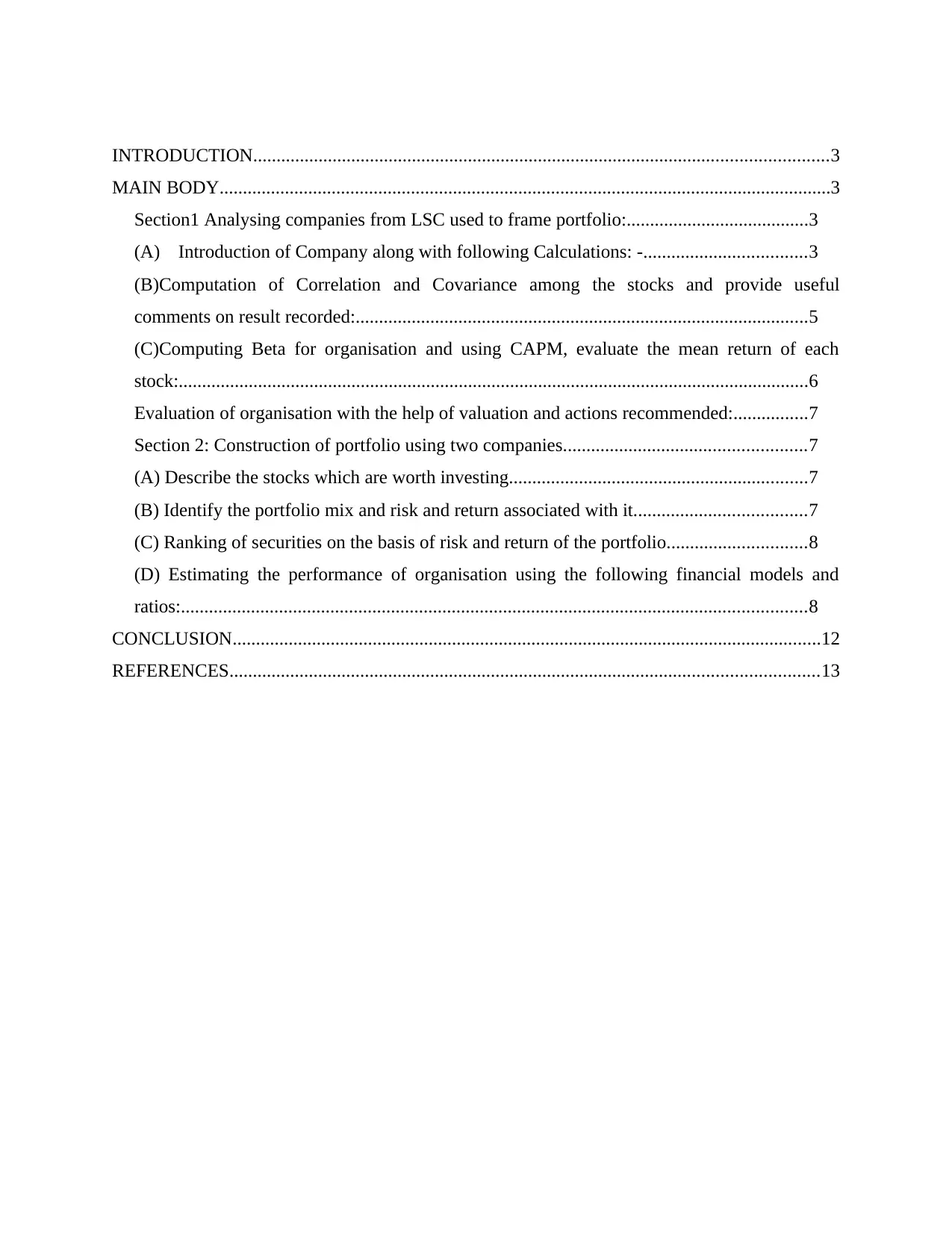
INTRODUCTION...........................................................................................................................3
MAIN BODY...................................................................................................................................3
Section1 Analysing companies from LSC used to frame portfolio:.......................................3
(A) Introduction of Company along with following Calculations: -...................................3
(B)Computation of Correlation and Covariance among the stocks and provide useful
comments on result recorded:.................................................................................................5
(C)Computing Beta for organisation and using CAPM, evaluate the mean return of each
stock:.......................................................................................................................................6
Evaluation of organisation with the help of valuation and actions recommended:................7
Section 2: Construction of portfolio using two companies....................................................7
(A) Describe the stocks which are worth investing................................................................7
(B) Identify the portfolio mix and risk and return associated with it.....................................7
(C) Ranking of securities on the basis of risk and return of the portfolio..............................8
(D) Estimating the performance of organisation using the following financial models and
ratios:......................................................................................................................................8
CONCLUSION..............................................................................................................................12
REFERENCES..............................................................................................................................13
MAIN BODY...................................................................................................................................3
Section1 Analysing companies from LSC used to frame portfolio:.......................................3
(A) Introduction of Company along with following Calculations: -...................................3
(B)Computation of Correlation and Covariance among the stocks and provide useful
comments on result recorded:.................................................................................................5
(C)Computing Beta for organisation and using CAPM, evaluate the mean return of each
stock:.......................................................................................................................................6
Evaluation of organisation with the help of valuation and actions recommended:................7
Section 2: Construction of portfolio using two companies....................................................7
(A) Describe the stocks which are worth investing................................................................7
(B) Identify the portfolio mix and risk and return associated with it.....................................7
(C) Ranking of securities on the basis of risk and return of the portfolio..............................8
(D) Estimating the performance of organisation using the following financial models and
ratios:......................................................................................................................................8
CONCLUSION..............................................................................................................................12
REFERENCES..............................................................................................................................13
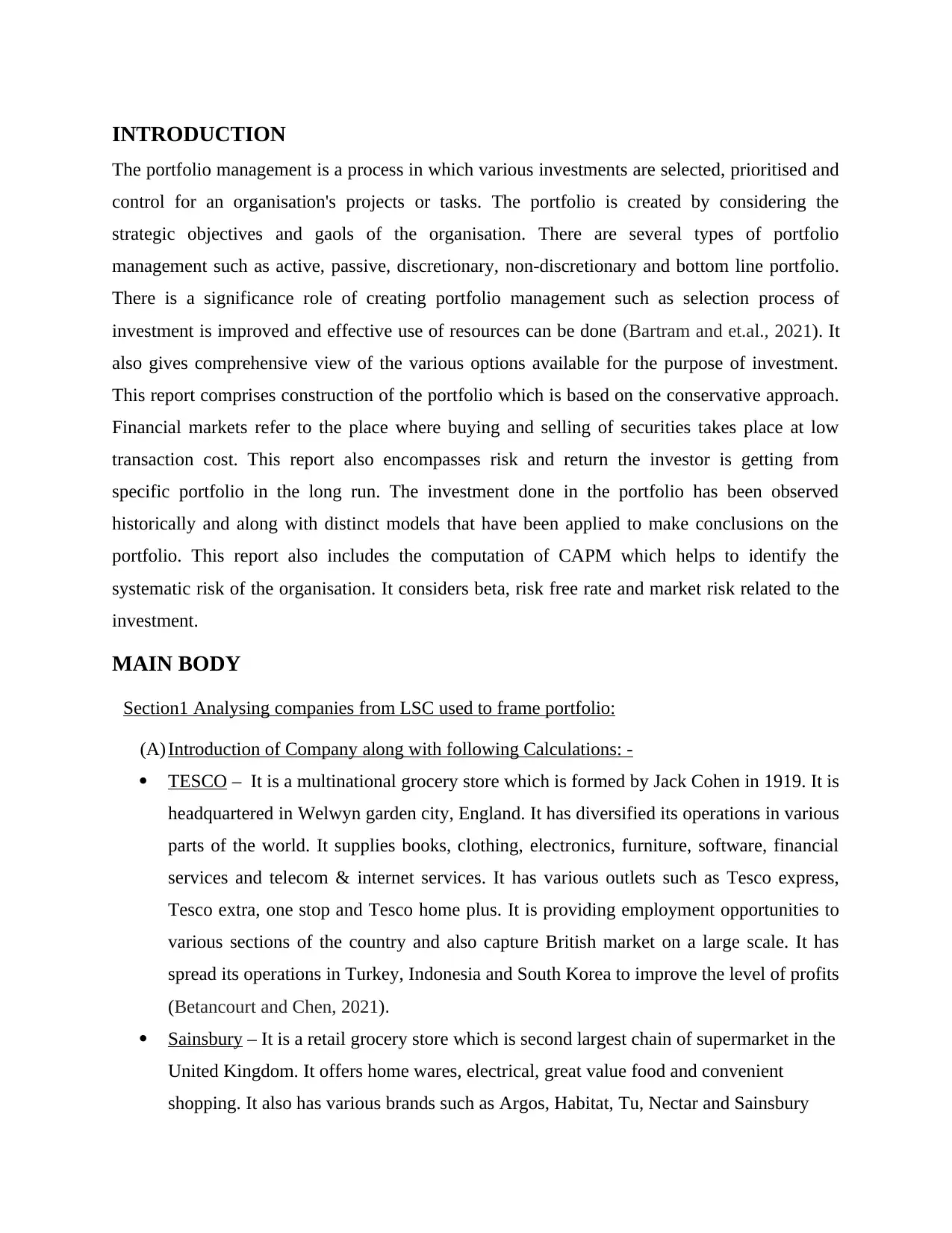
INTRODUCTION
The portfolio management is a process in which various investments are selected, prioritised and
control for an organisation's projects or tasks. The portfolio is created by considering the
strategic objectives and gaols of the organisation. There are several types of portfolio
management such as active, passive, discretionary, non-discretionary and bottom line portfolio.
There is a significance role of creating portfolio management such as selection process of
investment is improved and effective use of resources can be done (Bartram and et.al., 2021). It
also gives comprehensive view of the various options available for the purpose of investment.
This report comprises construction of the portfolio which is based on the conservative approach.
Financial markets refer to the place where buying and selling of securities takes place at low
transaction cost. This report also encompasses risk and return the investor is getting from
specific portfolio in the long run. The investment done in the portfolio has been observed
historically and along with distinct models that have been applied to make conclusions on the
portfolio. This report also includes the computation of CAPM which helps to identify the
systematic risk of the organisation. It considers beta, risk free rate and market risk related to the
investment.
MAIN BODY
Section1 Analysing companies from LSC used to frame portfolio:
(A) Introduction of Company along with following Calculations: -
TESCO – It is a multinational grocery store which is formed by Jack Cohen in 1919. It is
headquartered in Welwyn garden city, England. It has diversified its operations in various
parts of the world. It supplies books, clothing, electronics, furniture, software, financial
services and telecom & internet services. It has various outlets such as Tesco express,
Tesco extra, one stop and Tesco home plus. It is providing employment opportunities to
various sections of the country and also capture British market on a large scale. It has
spread its operations in Turkey, Indonesia and South Korea to improve the level of profits
(Betancourt and Chen, 2021).
Sainsbury – It is a retail grocery store which is second largest chain of supermarket in the
United Kingdom. It offers home wares, electrical, great value food and convenient
shopping. It also has various brands such as Argos, Habitat, Tu, Nectar and Sainsbury
The portfolio management is a process in which various investments are selected, prioritised and
control for an organisation's projects or tasks. The portfolio is created by considering the
strategic objectives and gaols of the organisation. There are several types of portfolio
management such as active, passive, discretionary, non-discretionary and bottom line portfolio.
There is a significance role of creating portfolio management such as selection process of
investment is improved and effective use of resources can be done (Bartram and et.al., 2021). It
also gives comprehensive view of the various options available for the purpose of investment.
This report comprises construction of the portfolio which is based on the conservative approach.
Financial markets refer to the place where buying and selling of securities takes place at low
transaction cost. This report also encompasses risk and return the investor is getting from
specific portfolio in the long run. The investment done in the portfolio has been observed
historically and along with distinct models that have been applied to make conclusions on the
portfolio. This report also includes the computation of CAPM which helps to identify the
systematic risk of the organisation. It considers beta, risk free rate and market risk related to the
investment.
MAIN BODY
Section1 Analysing companies from LSC used to frame portfolio:
(A) Introduction of Company along with following Calculations: -
TESCO – It is a multinational grocery store which is formed by Jack Cohen in 1919. It is
headquartered in Welwyn garden city, England. It has diversified its operations in various
parts of the world. It supplies books, clothing, electronics, furniture, software, financial
services and telecom & internet services. It has various outlets such as Tesco express,
Tesco extra, one stop and Tesco home plus. It is providing employment opportunities to
various sections of the country and also capture British market on a large scale. It has
spread its operations in Turkey, Indonesia and South Korea to improve the level of profits
(Betancourt and Chen, 2021).
Sainsbury – It is a retail grocery store which is second largest chain of supermarket in the
United Kingdom. It offers home wares, electrical, great value food and convenient
shopping. It also has various brands such as Argos, Habitat, Tu, Nectar and Sainsbury
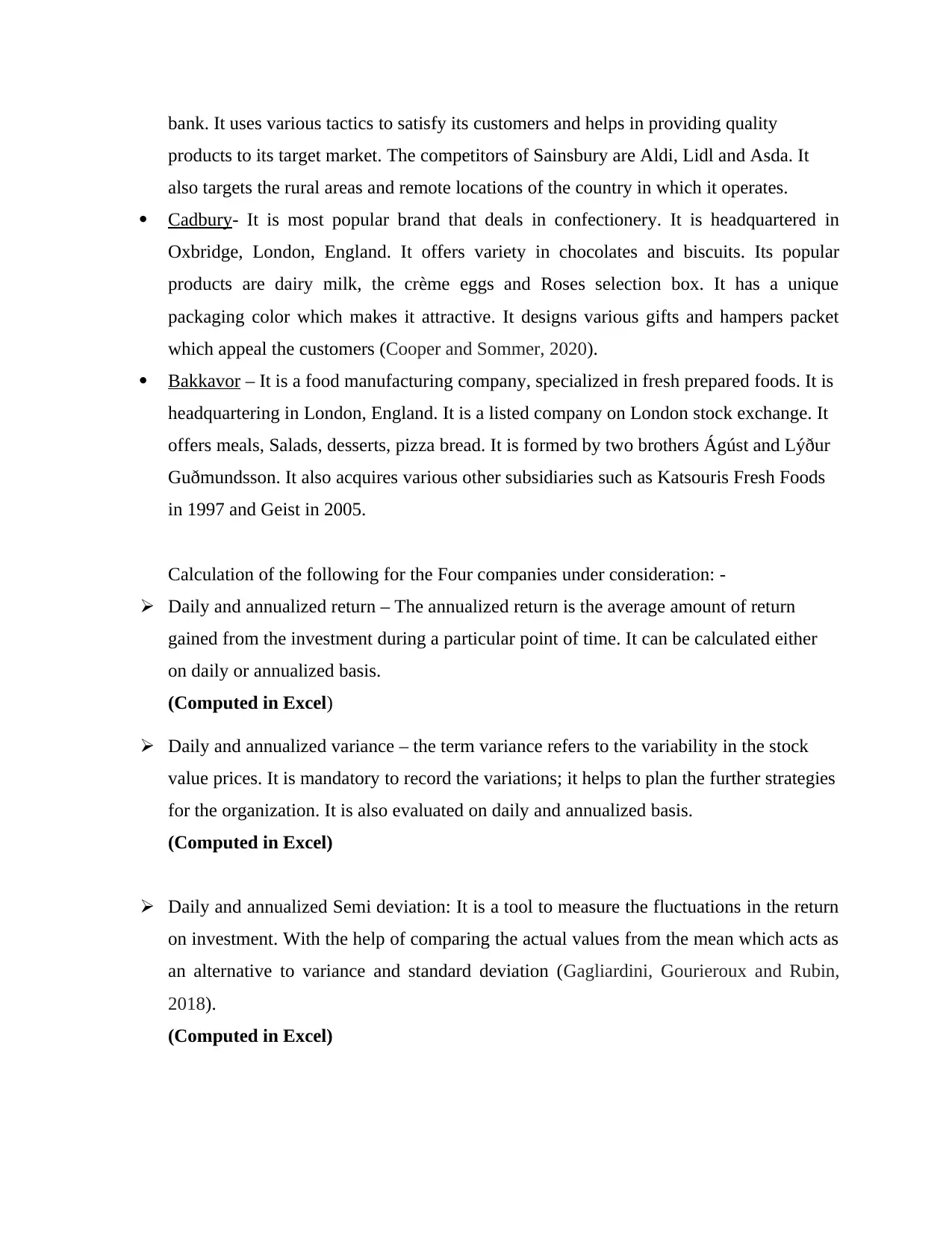
bank. It uses various tactics to satisfy its customers and helps in providing quality
products to its target market. The competitors of Sainsbury are Aldi, Lidl and Asda. It
also targets the rural areas and remote locations of the country in which it operates.
Cadbury- It is most popular brand that deals in confectionery. It is headquartered in
Oxbridge, London, England. It offers variety in chocolates and biscuits. Its popular
products are dairy milk, the crème eggs and Roses selection box. It has a unique
packaging color which makes it attractive. It designs various gifts and hampers packet
which appeal the customers (Cooper and Sommer, 2020).
Bakkavor – It is a food manufacturing company, specialized in fresh prepared foods. It is
headquartering in London, England. It is a listed company on London stock exchange. It
offers meals, Salads, desserts, pizza bread. It is formed by two brothers Ágúst and Lýður
Guðmundsson. It also acquires various other subsidiaries such as Katsouris Fresh Foods
in 1997 and Geist in 2005.
Calculation of the following for the Four companies under consideration: -
Daily and annualized return – The annualized return is the average amount of return
gained from the investment during a particular point of time. It can be calculated either
on daily or annualized basis.
(Computed in Excel)
Daily and annualized variance – the term variance refers to the variability in the stock
value prices. It is mandatory to record the variations; it helps to plan the further strategies
for the organization. It is also evaluated on daily and annualized basis.
(Computed in Excel)
Daily and annualized Semi deviation: It is a tool to measure the fluctuations in the return
on investment. With the help of comparing the actual values from the mean which acts as
an alternative to variance and standard deviation (Gagliardini, Gourieroux and Rubin,
2018).
(Computed in Excel)
products to its target market. The competitors of Sainsbury are Aldi, Lidl and Asda. It
also targets the rural areas and remote locations of the country in which it operates.
Cadbury- It is most popular brand that deals in confectionery. It is headquartered in
Oxbridge, London, England. It offers variety in chocolates and biscuits. Its popular
products are dairy milk, the crème eggs and Roses selection box. It has a unique
packaging color which makes it attractive. It designs various gifts and hampers packet
which appeal the customers (Cooper and Sommer, 2020).
Bakkavor – It is a food manufacturing company, specialized in fresh prepared foods. It is
headquartering in London, England. It is a listed company on London stock exchange. It
offers meals, Salads, desserts, pizza bread. It is formed by two brothers Ágúst and Lýður
Guðmundsson. It also acquires various other subsidiaries such as Katsouris Fresh Foods
in 1997 and Geist in 2005.
Calculation of the following for the Four companies under consideration: -
Daily and annualized return – The annualized return is the average amount of return
gained from the investment during a particular point of time. It can be calculated either
on daily or annualized basis.
(Computed in Excel)
Daily and annualized variance – the term variance refers to the variability in the stock
value prices. It is mandatory to record the variations; it helps to plan the further strategies
for the organization. It is also evaluated on daily and annualized basis.
(Computed in Excel)
Daily and annualized Semi deviation: It is a tool to measure the fluctuations in the return
on investment. With the help of comparing the actual values from the mean which acts as
an alternative to variance and standard deviation (Gagliardini, Gourieroux and Rubin,
2018).
(Computed in Excel)
Secure Best Marks with AI Grader
Need help grading? Try our AI Grader for instant feedback on your assignments.
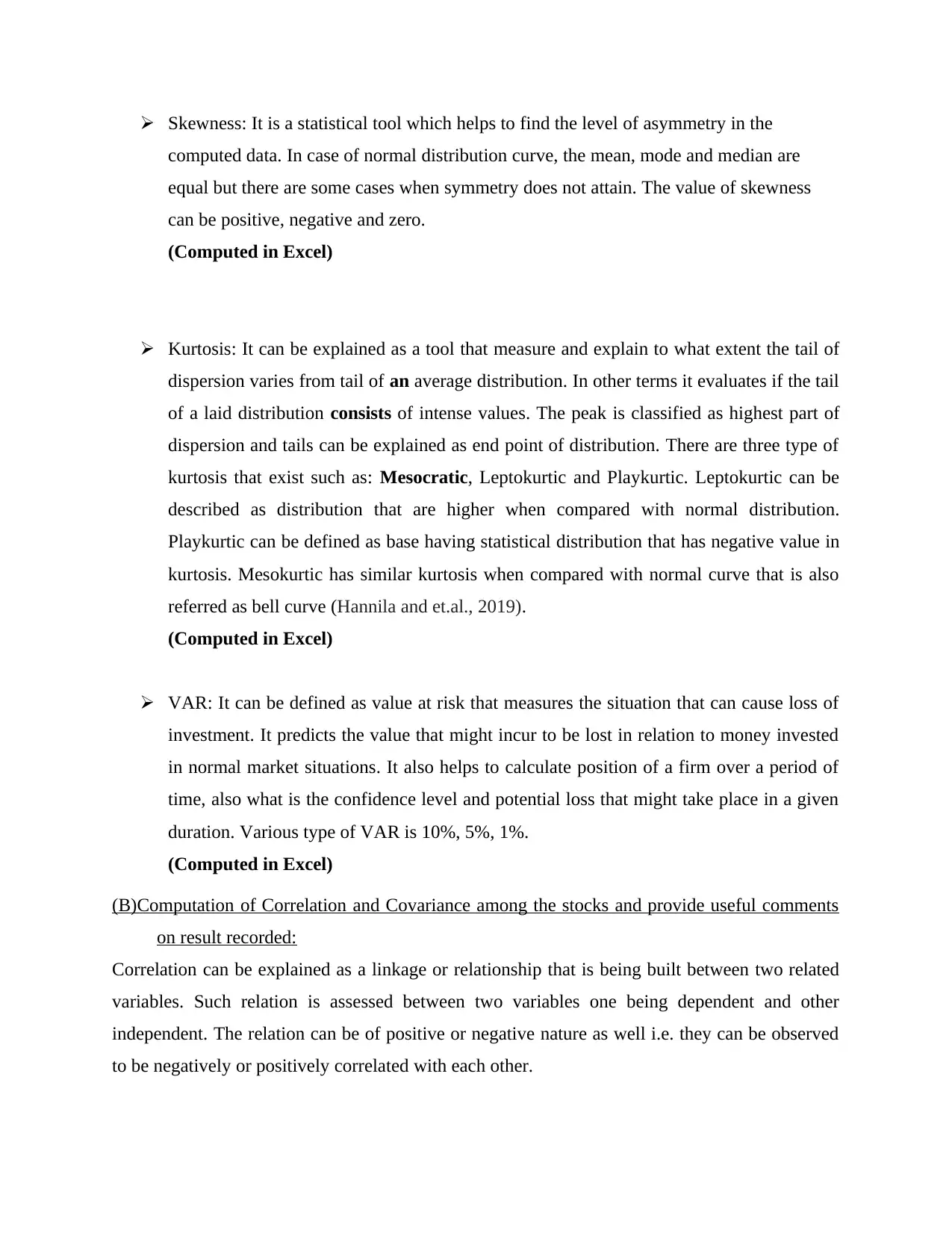
Skewness: It is a statistical tool which helps to find the level of asymmetry in the
computed data. In case of normal distribution curve, the mean, mode and median are
equal but there are some cases when symmetry does not attain. The value of skewness
can be positive, negative and zero.
(Computed in Excel)
Kurtosis: It can be explained as a tool that measure and explain to what extent the tail of
dispersion varies from tail of an average distribution. In other terms it evaluates if the tail
of a laid distribution consists of intense values. The peak is classified as highest part of
dispersion and tails can be explained as end point of distribution. There are three type of
kurtosis that exist such as: Mesocratic, Leptokurtic and Playkurtic. Leptokurtic can be
described as distribution that are higher when compared with normal distribution.
Playkurtic can be defined as base having statistical distribution that has negative value in
kurtosis. Mesokurtic has similar kurtosis when compared with normal curve that is also
referred as bell curve (Hannila and et.al., 2019).
(Computed in Excel)
VAR: It can be defined as value at risk that measures the situation that can cause loss of
investment. It predicts the value that might incur to be lost in relation to money invested
in normal market situations. It also helps to calculate position of a firm over a period of
time, also what is the confidence level and potential loss that might take place in a given
duration. Various type of VAR is 10%, 5%, 1%.
(Computed in Excel)
(B)Computation of Correlation and Covariance among the stocks and provide useful comments
on result recorded:
Correlation can be explained as a linkage or relationship that is being built between two related
variables. Such relation is assessed between two variables one being dependent and other
independent. The relation can be of positive or negative nature as well i.e. they can be observed
to be negatively or positively correlated with each other.
computed data. In case of normal distribution curve, the mean, mode and median are
equal but there are some cases when symmetry does not attain. The value of skewness
can be positive, negative and zero.
(Computed in Excel)
Kurtosis: It can be explained as a tool that measure and explain to what extent the tail of
dispersion varies from tail of an average distribution. In other terms it evaluates if the tail
of a laid distribution consists of intense values. The peak is classified as highest part of
dispersion and tails can be explained as end point of distribution. There are three type of
kurtosis that exist such as: Mesocratic, Leptokurtic and Playkurtic. Leptokurtic can be
described as distribution that are higher when compared with normal distribution.
Playkurtic can be defined as base having statistical distribution that has negative value in
kurtosis. Mesokurtic has similar kurtosis when compared with normal curve that is also
referred as bell curve (Hannila and et.al., 2019).
(Computed in Excel)
VAR: It can be defined as value at risk that measures the situation that can cause loss of
investment. It predicts the value that might incur to be lost in relation to money invested
in normal market situations. It also helps to calculate position of a firm over a period of
time, also what is the confidence level and potential loss that might take place in a given
duration. Various type of VAR is 10%, 5%, 1%.
(Computed in Excel)
(B)Computation of Correlation and Covariance among the stocks and provide useful comments
on result recorded:
Correlation can be explained as a linkage or relationship that is being built between two related
variables. Such relation is assessed between two variables one being dependent and other
independent. The relation can be of positive or negative nature as well i.e. they can be observed
to be negatively or positively correlated with each other.
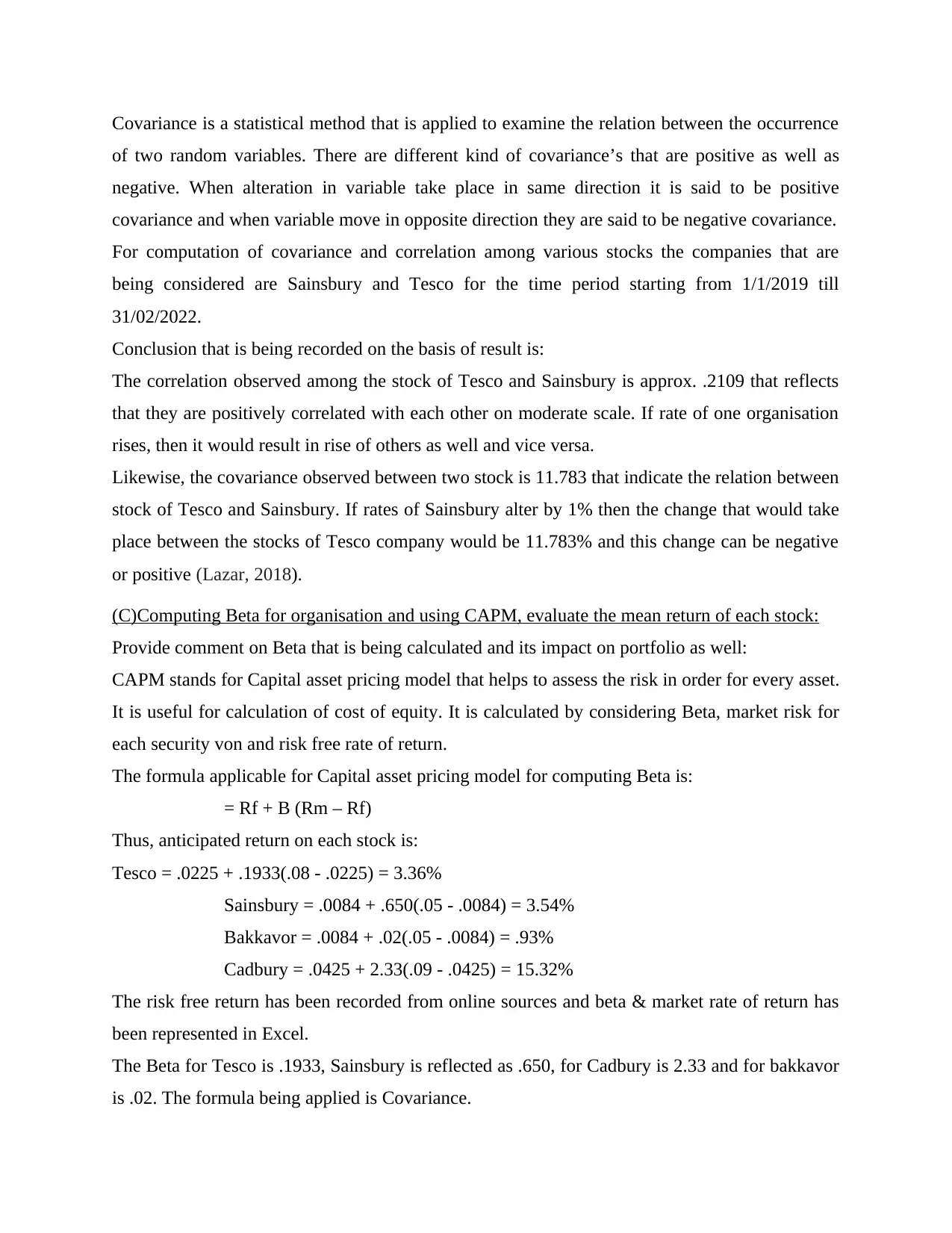
Covariance is a statistical method that is applied to examine the relation between the occurrence
of two random variables. There are different kind of covariance’s that are positive as well as
negative. When alteration in variable take place in same direction it is said to be positive
covariance and when variable move in opposite direction they are said to be negative covariance.
For computation of covariance and correlation among various stocks the companies that are
being considered are Sainsbury and Tesco for the time period starting from 1/1/2019 till
31/02/2022.
Conclusion that is being recorded on the basis of result is:
The correlation observed among the stock of Tesco and Sainsbury is approx. .2109 that reflects
that they are positively correlated with each other on moderate scale. If rate of one organisation
rises, then it would result in rise of others as well and vice versa.
Likewise, the covariance observed between two stock is 11.783 that indicate the relation between
stock of Tesco and Sainsbury. If rates of Sainsbury alter by 1% then the change that would take
place between the stocks of Tesco company would be 11.783% and this change can be negative
or positive (Lazar, 2018).
(C)Computing Beta for organisation and using CAPM, evaluate the mean return of each stock:
Provide comment on Beta that is being calculated and its impact on portfolio as well:
CAPM stands for Capital asset pricing model that helps to assess the risk in order for every asset.
It is useful for calculation of cost of equity. It is calculated by considering Beta, market risk for
each security von and risk free rate of return.
The formula applicable for Capital asset pricing model for computing Beta is:
= Rf + B (Rm – Rf)
Thus, anticipated return on each stock is:
Tesco = .0225 + .1933(.08 - .0225) = 3.36%
Sainsbury = .0084 + .650(.05 - .0084) = 3.54%
Bakkavor = .0084 + .02(.05 - .0084) = .93%
Cadbury = .0425 + 2.33(.09 - .0425) = 15.32%
The risk free return has been recorded from online sources and beta & market rate of return has
been represented in Excel.
The Beta for Tesco is .1933, Sainsbury is reflected as .650, for Cadbury is 2.33 and for bakkavor
is .02. The formula being applied is Covariance.
of two random variables. There are different kind of covariance’s that are positive as well as
negative. When alteration in variable take place in same direction it is said to be positive
covariance and when variable move in opposite direction they are said to be negative covariance.
For computation of covariance and correlation among various stocks the companies that are
being considered are Sainsbury and Tesco for the time period starting from 1/1/2019 till
31/02/2022.
Conclusion that is being recorded on the basis of result is:
The correlation observed among the stock of Tesco and Sainsbury is approx. .2109 that reflects
that they are positively correlated with each other on moderate scale. If rate of one organisation
rises, then it would result in rise of others as well and vice versa.
Likewise, the covariance observed between two stock is 11.783 that indicate the relation between
stock of Tesco and Sainsbury. If rates of Sainsbury alter by 1% then the change that would take
place between the stocks of Tesco company would be 11.783% and this change can be negative
or positive (Lazar, 2018).
(C)Computing Beta for organisation and using CAPM, evaluate the mean return of each stock:
Provide comment on Beta that is being calculated and its impact on portfolio as well:
CAPM stands for Capital asset pricing model that helps to assess the risk in order for every asset.
It is useful for calculation of cost of equity. It is calculated by considering Beta, market risk for
each security von and risk free rate of return.
The formula applicable for Capital asset pricing model for computing Beta is:
= Rf + B (Rm – Rf)
Thus, anticipated return on each stock is:
Tesco = .0225 + .1933(.08 - .0225) = 3.36%
Sainsbury = .0084 + .650(.05 - .0084) = 3.54%
Bakkavor = .0084 + .02(.05 - .0084) = .93%
Cadbury = .0425 + 2.33(.09 - .0425) = 15.32%
The risk free return has been recorded from online sources and beta & market rate of return has
been represented in Excel.
The Beta for Tesco is .1933, Sainsbury is reflected as .650, for Cadbury is 2.33 and for bakkavor
is .02. The formula being applied is Covariance.
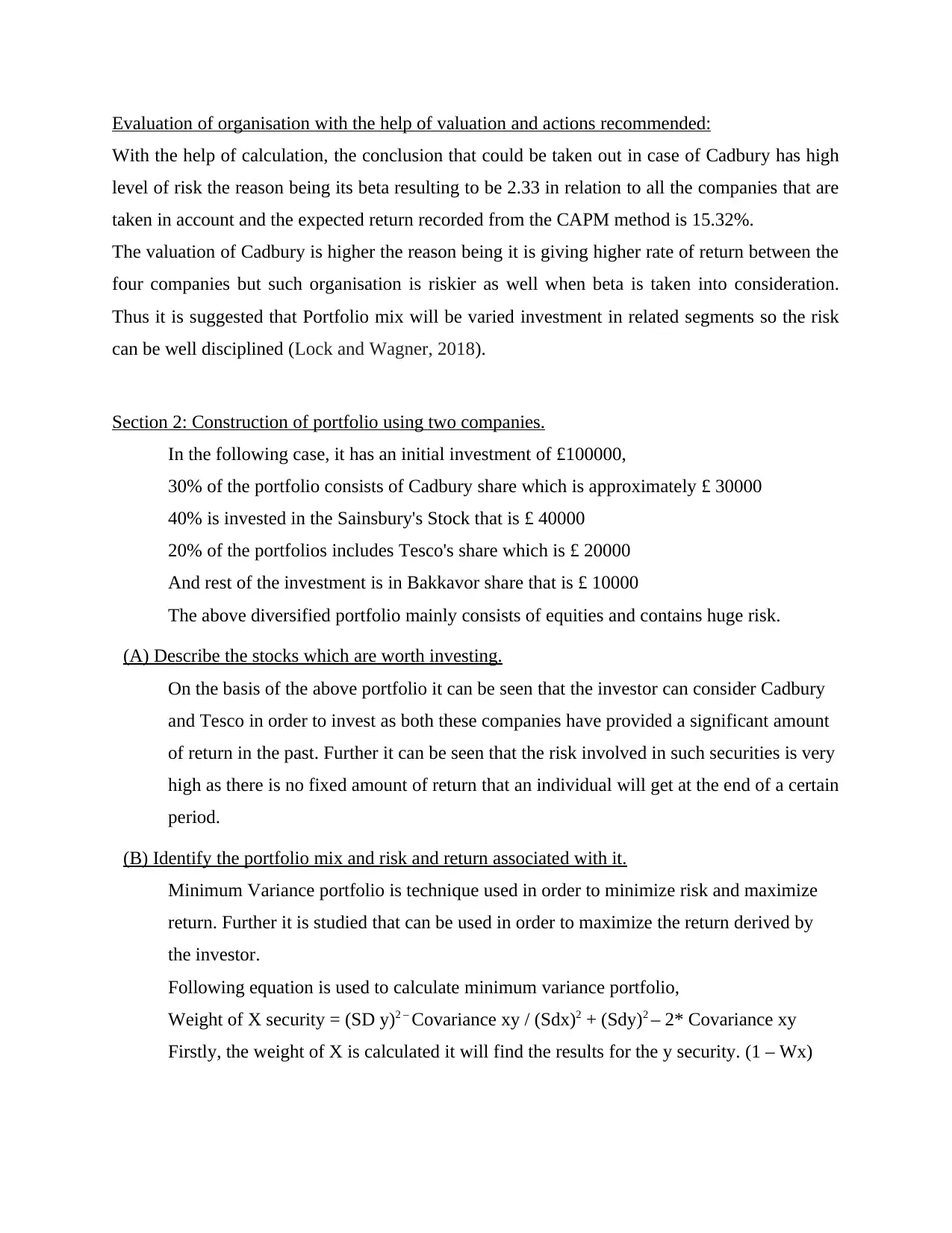
Evaluation of organisation with the help of valuation and actions recommended:
With the help of calculation, the conclusion that could be taken out in case of Cadbury has high
level of risk the reason being its beta resulting to be 2.33 in relation to all the companies that are
taken in account and the expected return recorded from the CAPM method is 15.32%.
The valuation of Cadbury is higher the reason being it is giving higher rate of return between the
four companies but such organisation is riskier as well when beta is taken into consideration.
Thus it is suggested that Portfolio mix will be varied investment in related segments so the risk
can be well disciplined (Lock and Wagner, 2018).
Section 2: Construction of portfolio using two companies.
In the following case, it has an initial investment of £100000,
30% of the portfolio consists of Cadbury share which is approximately £ 30000
40% is invested in the Sainsbury's Stock that is £ 40000
20% of the portfolios includes Tesco's share which is £ 20000
And rest of the investment is in Bakkavor share that is £ 10000
The above diversified portfolio mainly consists of equities and contains huge risk.
(A) Describe the stocks which are worth investing.
On the basis of the above portfolio it can be seen that the investor can consider Cadbury
and Tesco in order to invest as both these companies have provided a significant amount
of return in the past. Further it can be seen that the risk involved in such securities is very
high as there is no fixed amount of return that an individual will get at the end of a certain
period.
(B) Identify the portfolio mix and risk and return associated with it.
Minimum Variance portfolio is technique used in order to minimize risk and maximize
return. Further it is studied that can be used in order to maximize the return derived by
the investor.
Following equation is used to calculate minimum variance portfolio,
Weight of X security = (SD y)2 – Covariance xy / (Sdx)2 + (Sdy)2 – 2* Covariance xy
Firstly, the weight of X is calculated it will find the results for the y security. (1 – Wx)
With the help of calculation, the conclusion that could be taken out in case of Cadbury has high
level of risk the reason being its beta resulting to be 2.33 in relation to all the companies that are
taken in account and the expected return recorded from the CAPM method is 15.32%.
The valuation of Cadbury is higher the reason being it is giving higher rate of return between the
four companies but such organisation is riskier as well when beta is taken into consideration.
Thus it is suggested that Portfolio mix will be varied investment in related segments so the risk
can be well disciplined (Lock and Wagner, 2018).
Section 2: Construction of portfolio using two companies.
In the following case, it has an initial investment of £100000,
30% of the portfolio consists of Cadbury share which is approximately £ 30000
40% is invested in the Sainsbury's Stock that is £ 40000
20% of the portfolios includes Tesco's share which is £ 20000
And rest of the investment is in Bakkavor share that is £ 10000
The above diversified portfolio mainly consists of equities and contains huge risk.
(A) Describe the stocks which are worth investing.
On the basis of the above portfolio it can be seen that the investor can consider Cadbury
and Tesco in order to invest as both these companies have provided a significant amount
of return in the past. Further it can be seen that the risk involved in such securities is very
high as there is no fixed amount of return that an individual will get at the end of a certain
period.
(B) Identify the portfolio mix and risk and return associated with it.
Minimum Variance portfolio is technique used in order to minimize risk and maximize
return. Further it is studied that can be used in order to maximize the return derived by
the investor.
Following equation is used to calculate minimum variance portfolio,
Weight of X security = (SD y)2 – Covariance xy / (Sdx)2 + (Sdy)2 – 2* Covariance xy
Firstly, the weight of X is calculated it will find the results for the y security. (1 – Wx)
Paraphrase This Document
Need a fresh take? Get an instant paraphrase of this document with our AI Paraphraser
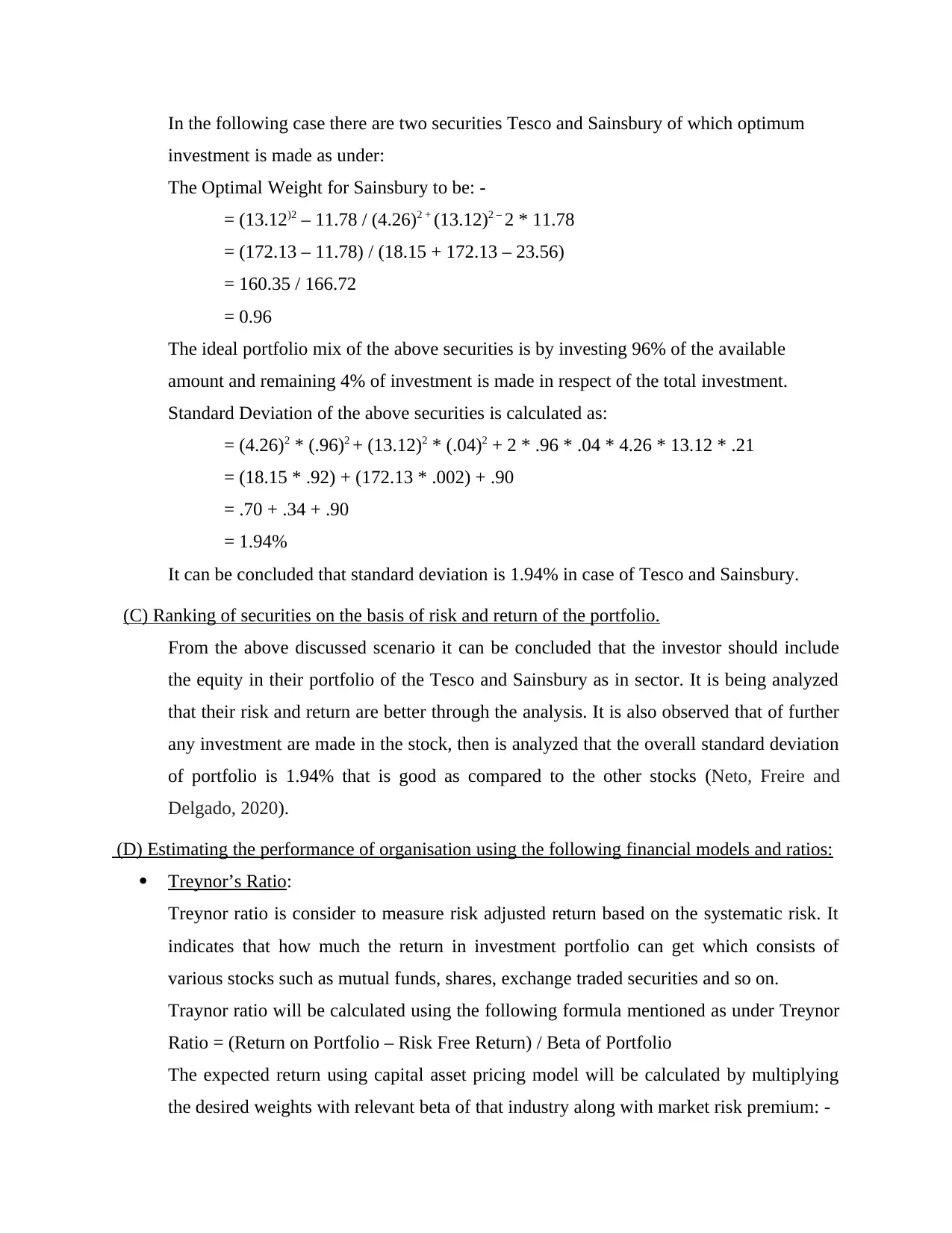
In the following case there are two securities Tesco and Sainsbury of which optimum
investment is made as under:
The Optimal Weight for Sainsbury to be: -
= (13.12)2 – 11.78 / (4.26)2 + (13.12)2 – 2 * 11.78
= (172.13 – 11.78) / (18.15 + 172.13 – 23.56)
= 160.35 / 166.72
= 0.96
The ideal portfolio mix of the above securities is by investing 96% of the available
amount and remaining 4% of investment is made in respect of the total investment.
Standard Deviation of the above securities is calculated as:
= (4.26)2 * (.96)2 + (13.12)2 * (.04)2 + 2 * .96 * .04 * 4.26 * 13.12 * .21
= (18.15 * .92) + (172.13 * .002) + .90
= .70 + .34 + .90
= 1.94%
It can be concluded that standard deviation is 1.94% in case of Tesco and Sainsbury.
(C) Ranking of securities on the basis of risk and return of the portfolio.
From the above discussed scenario it can be concluded that the investor should include
the equity in their portfolio of the Tesco and Sainsbury as in sector. It is being analyzed
that their risk and return are better through the analysis. It is also observed that of further
any investment are made in the stock, then is analyzed that the overall standard deviation
of portfolio is 1.94% that is good as compared to the other stocks (Neto, Freire and
Delgado, 2020).
(D) Estimating the performance of organisation using the following financial models and ratios:
Treynor’s Ratio:
Treynor ratio is consider to measure risk adjusted return based on the systematic risk. It
indicates that how much the return in investment portfolio can get which consists of
various stocks such as mutual funds, shares, exchange traded securities and so on.
Traynor ratio will be calculated using the following formula mentioned as under Treynor
Ratio = (Return on Portfolio – Risk Free Return) / Beta of Portfolio
The expected return using capital asset pricing model will be calculated by multiplying
the desired weights with relevant beta of that industry along with market risk premium: -
investment is made as under:
The Optimal Weight for Sainsbury to be: -
= (13.12)2 – 11.78 / (4.26)2 + (13.12)2 – 2 * 11.78
= (172.13 – 11.78) / (18.15 + 172.13 – 23.56)
= 160.35 / 166.72
= 0.96
The ideal portfolio mix of the above securities is by investing 96% of the available
amount and remaining 4% of investment is made in respect of the total investment.
Standard Deviation of the above securities is calculated as:
= (4.26)2 * (.96)2 + (13.12)2 * (.04)2 + 2 * .96 * .04 * 4.26 * 13.12 * .21
= (18.15 * .92) + (172.13 * .002) + .90
= .70 + .34 + .90
= 1.94%
It can be concluded that standard deviation is 1.94% in case of Tesco and Sainsbury.
(C) Ranking of securities on the basis of risk and return of the portfolio.
From the above discussed scenario it can be concluded that the investor should include
the equity in their portfolio of the Tesco and Sainsbury as in sector. It is being analyzed
that their risk and return are better through the analysis. It is also observed that of further
any investment are made in the stock, then is analyzed that the overall standard deviation
of portfolio is 1.94% that is good as compared to the other stocks (Neto, Freire and
Delgado, 2020).
(D) Estimating the performance of organisation using the following financial models and ratios:
Treynor’s Ratio:
Treynor ratio is consider to measure risk adjusted return based on the systematic risk. It
indicates that how much the return in investment portfolio can get which consists of
various stocks such as mutual funds, shares, exchange traded securities and so on.
Traynor ratio will be calculated using the following formula mentioned as under Treynor
Ratio = (Return on Portfolio – Risk Free Return) / Beta of Portfolio
The expected return using capital asset pricing model will be calculated by multiplying
the desired weights with relevant beta of that industry along with market risk premium: -
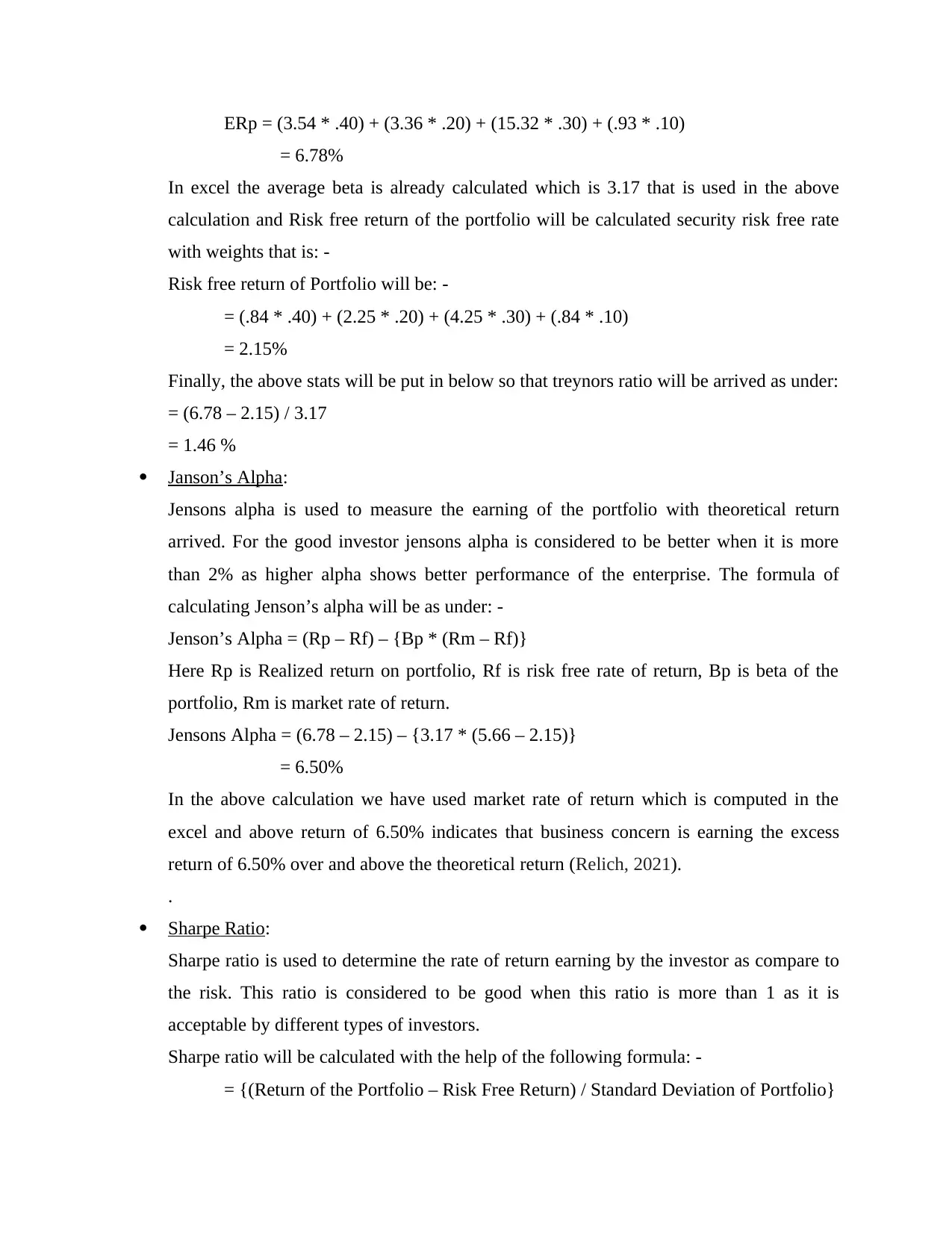
ERp = (3.54 * .40) + (3.36 * .20) + (15.32 * .30) + (.93 * .10)
= 6.78%
In excel the average beta is already calculated which is 3.17 that is used in the above
calculation and Risk free return of the portfolio will be calculated security risk free rate
with weights that is: -
Risk free return of Portfolio will be: -
= (.84 * .40) + (2.25 * .20) + (4.25 * .30) + (.84 * .10)
= 2.15%
Finally, the above stats will be put in below so that treynors ratio will be arrived as under:
= (6.78 – 2.15) / 3.17
= 1.46 %
Janson’s Alpha:
Jensons alpha is used to measure the earning of the portfolio with theoretical return
arrived. For the good investor jensons alpha is considered to be better when it is more
than 2% as higher alpha shows better performance of the enterprise. The formula of
calculating Jenson’s alpha will be as under: -
Jenson’s Alpha = (Rp – Rf) – {Bp * (Rm – Rf)}
Here Rp is Realized return on portfolio, Rf is risk free rate of return, Bp is beta of the
portfolio, Rm is market rate of return.
Jensons Alpha = (6.78 – 2.15) – {3.17 * (5.66 – 2.15)}
= 6.50%
In the above calculation we have used market rate of return which is computed in the
excel and above return of 6.50% indicates that business concern is earning the excess
return of 6.50% over and above the theoretical return (Relich, 2021).
.
Sharpe Ratio:
Sharpe ratio is used to determine the rate of return earning by the investor as compare to
the risk. This ratio is considered to be good when this ratio is more than 1 as it is
acceptable by different types of investors.
Sharpe ratio will be calculated with the help of the following formula: -
= {(Return of the Portfolio – Risk Free Return) / Standard Deviation of Portfolio}
= 6.78%
In excel the average beta is already calculated which is 3.17 that is used in the above
calculation and Risk free return of the portfolio will be calculated security risk free rate
with weights that is: -
Risk free return of Portfolio will be: -
= (.84 * .40) + (2.25 * .20) + (4.25 * .30) + (.84 * .10)
= 2.15%
Finally, the above stats will be put in below so that treynors ratio will be arrived as under:
= (6.78 – 2.15) / 3.17
= 1.46 %
Janson’s Alpha:
Jensons alpha is used to measure the earning of the portfolio with theoretical return
arrived. For the good investor jensons alpha is considered to be better when it is more
than 2% as higher alpha shows better performance of the enterprise. The formula of
calculating Jenson’s alpha will be as under: -
Jenson’s Alpha = (Rp – Rf) – {Bp * (Rm – Rf)}
Here Rp is Realized return on portfolio, Rf is risk free rate of return, Bp is beta of the
portfolio, Rm is market rate of return.
Jensons Alpha = (6.78 – 2.15) – {3.17 * (5.66 – 2.15)}
= 6.50%
In the above calculation we have used market rate of return which is computed in the
excel and above return of 6.50% indicates that business concern is earning the excess
return of 6.50% over and above the theoretical return (Relich, 2021).
.
Sharpe Ratio:
Sharpe ratio is used to determine the rate of return earning by the investor as compare to
the risk. This ratio is considered to be good when this ratio is more than 1 as it is
acceptable by different types of investors.
Sharpe ratio will be calculated with the help of the following formula: -
= {(Return of the Portfolio – Risk Free Return) / Standard Deviation of Portfolio}
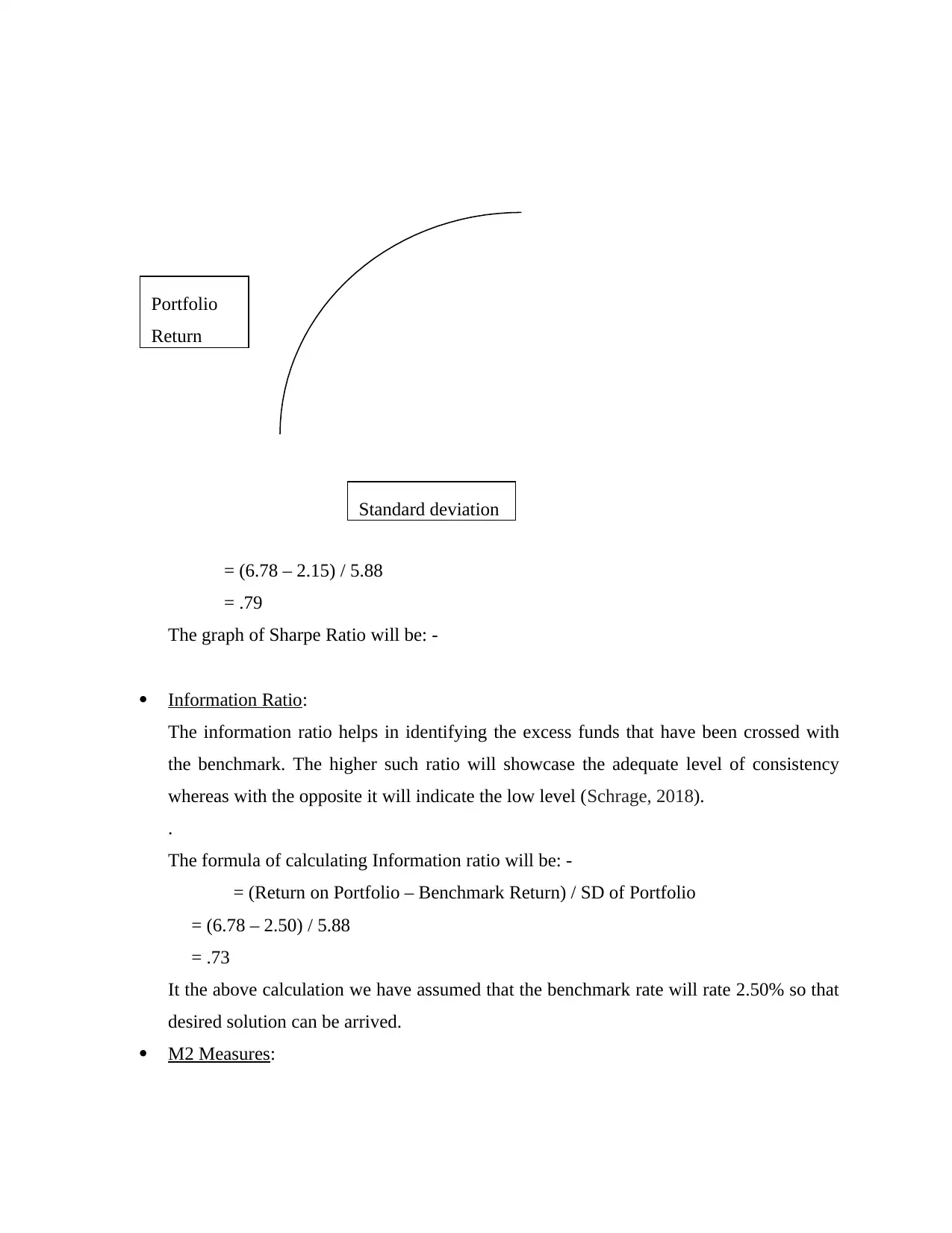
= (6.78 – 2.15) / 5.88
= .79
The graph of Sharpe Ratio will be: -
Information Ratio:
The information ratio helps in identifying the excess funds that have been crossed with
the benchmark. The higher such ratio will showcase the adequate level of consistency
whereas with the opposite it will indicate the low level (Schrage, 2018).
.
The formula of calculating Information ratio will be: -
= (Return on Portfolio – Benchmark Return) / SD of Portfolio
= (6.78 – 2.50) / 5.88
= .73
It the above calculation we have assumed that the benchmark rate will rate 2.50% so that
desired solution can be arrived.
M2 Measures:
Standard deviation
Portfolio
Return
= .79
The graph of Sharpe Ratio will be: -
Information Ratio:
The information ratio helps in identifying the excess funds that have been crossed with
the benchmark. The higher such ratio will showcase the adequate level of consistency
whereas with the opposite it will indicate the low level (Schrage, 2018).
.
The formula of calculating Information ratio will be: -
= (Return on Portfolio – Benchmark Return) / SD of Portfolio
= (6.78 – 2.50) / 5.88
= .73
It the above calculation we have assumed that the benchmark rate will rate 2.50% so that
desired solution can be arrived.
M2 Measures:
Standard deviation
Portfolio
Return
Secure Best Marks with AI Grader
Need help grading? Try our AI Grader for instant feedback on your assignments.
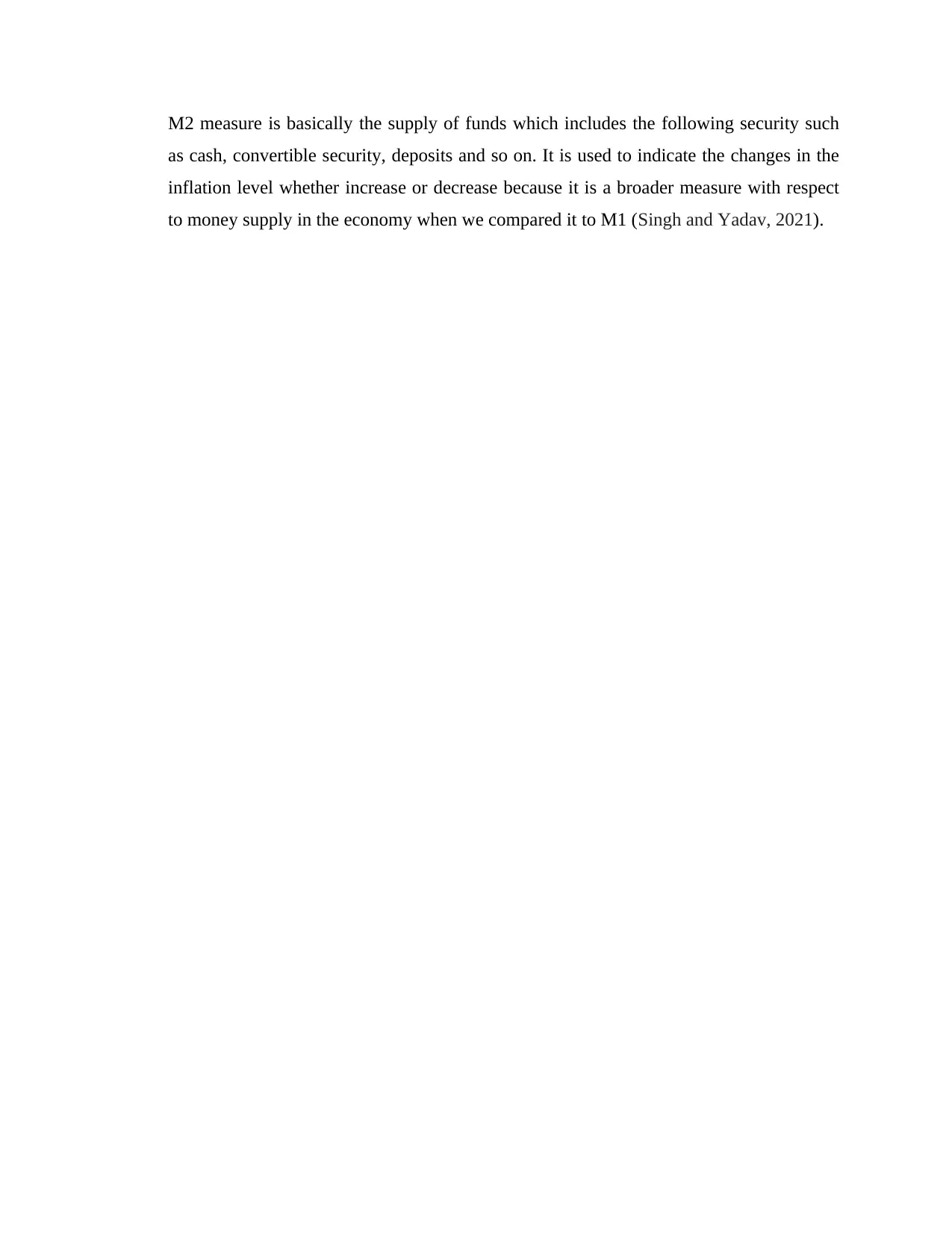
M2 measure is basically the supply of funds which includes the following security such
as cash, convertible security, deposits and so on. It is used to indicate the changes in the
inflation level whether increase or decrease because it is a broader measure with respect
to money supply in the economy when we compared it to M1 (Singh and Yadav, 2021).
as cash, convertible security, deposits and so on. It is used to indicate the changes in the
inflation level whether increase or decrease because it is a broader measure with respect
to money supply in the economy when we compared it to M1 (Singh and Yadav, 2021).
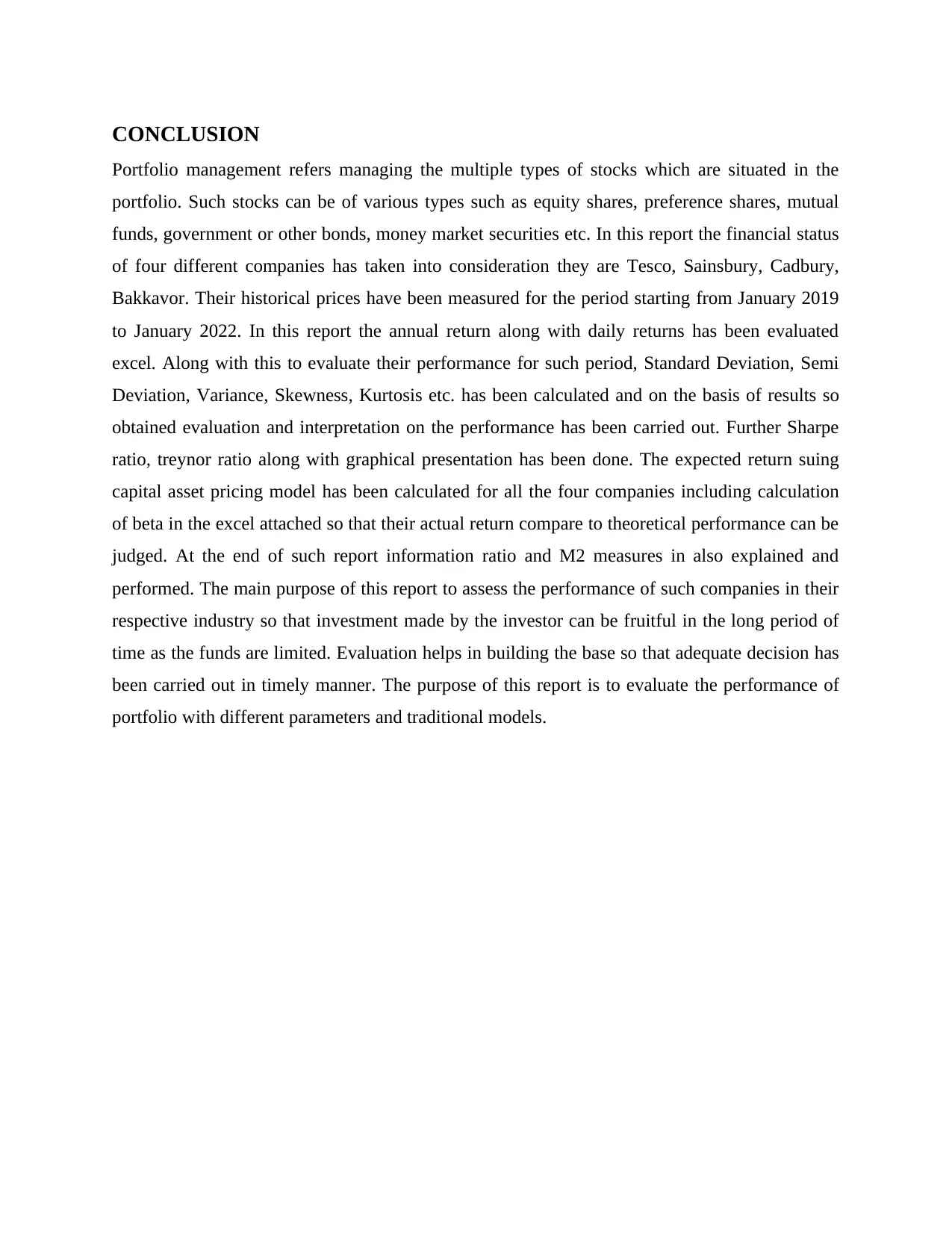
CONCLUSION
Portfolio management refers managing the multiple types of stocks which are situated in the
portfolio. Such stocks can be of various types such as equity shares, preference shares, mutual
funds, government or other bonds, money market securities etc. In this report the financial status
of four different companies has taken into consideration they are Tesco, Sainsbury, Cadbury,
Bakkavor. Their historical prices have been measured for the period starting from January 2019
to January 2022. In this report the annual return along with daily returns has been evaluated
excel. Along with this to evaluate their performance for such period, Standard Deviation, Semi
Deviation, Variance, Skewness, Kurtosis etc. has been calculated and on the basis of results so
obtained evaluation and interpretation on the performance has been carried out. Further Sharpe
ratio, treynor ratio along with graphical presentation has been done. The expected return suing
capital asset pricing model has been calculated for all the four companies including calculation
of beta in the excel attached so that their actual return compare to theoretical performance can be
judged. At the end of such report information ratio and M2 measures in also explained and
performed. The main purpose of this report to assess the performance of such companies in their
respective industry so that investment made by the investor can be fruitful in the long period of
time as the funds are limited. Evaluation helps in building the base so that adequate decision has
been carried out in timely manner. The purpose of this report is to evaluate the performance of
portfolio with different parameters and traditional models.
Portfolio management refers managing the multiple types of stocks which are situated in the
portfolio. Such stocks can be of various types such as equity shares, preference shares, mutual
funds, government or other bonds, money market securities etc. In this report the financial status
of four different companies has taken into consideration they are Tesco, Sainsbury, Cadbury,
Bakkavor. Their historical prices have been measured for the period starting from January 2019
to January 2022. In this report the annual return along with daily returns has been evaluated
excel. Along with this to evaluate their performance for such period, Standard Deviation, Semi
Deviation, Variance, Skewness, Kurtosis etc. has been calculated and on the basis of results so
obtained evaluation and interpretation on the performance has been carried out. Further Sharpe
ratio, treynor ratio along with graphical presentation has been done. The expected return suing
capital asset pricing model has been calculated for all the four companies including calculation
of beta in the excel attached so that their actual return compare to theoretical performance can be
judged. At the end of such report information ratio and M2 measures in also explained and
performed. The main purpose of this report to assess the performance of such companies in their
respective industry so that investment made by the investor can be fruitful in the long period of
time as the funds are limited. Evaluation helps in building the base so that adequate decision has
been carried out in timely manner. The purpose of this report is to evaluate the performance of
portfolio with different parameters and traditional models.

REFERENCES
Books and Journals
Bartram, S.M. and et.al., 2021. Machine Learning for Active Portfolio Management. The Journal
of Financial Data Science. 3(3). pp.9-30.
Betancourt, C. and Chen, W.H., 2021. Deep reinforcement learning for portfolio management of
markets with a dynamic number of assets. Expert Systems with Applications. 164.
p.114002.
Cooper, R.G. and Sommer, A.F., 2020. New-product portfolio management with agile: challenges
and solutions for manufacturers using agile development methods. Research-Technology
Management. 63(1). pp.29-38.
Gagliardini, P., Gourieroux, C. and Rubin, M., 2018. Positional portfolio management. Swiss
Finance Institute Research Paper. (14-20).
Hannila, H. and et.al., 2019. Product-level profitability: Current challenges and preconditions for
data-driven, fact-based product portfolio management. Journal of Enterprise Information
Management.
Lazar, O., 2018. The Four Pillars of Portfolio Management: Organizational Agility, Strategy,
Risk, and Resources. Auerbach Publications.
Lock, D. and Wagner, R. eds., 2018. The handbook of project portfolio management. Routledge.
Neto, E.L.P., Freire, V. and Delgado, K.V., 2020, October. Risk Sensitive Markov Decision
Process for Portfolio Management. In Mexican International Conference on Artificial
Intelligence (pp. 370-382). Springer, Cham.
Relich, M., 2021. A decision support system for portfolio management of NPD projects.
In Decision Support for Product Development (pp. 81-94). Springer, Cham.
Schrage, B., 2018. Project Portfolio Management Can Ensure Best Use of Time and
Resources. Natural Gas & Electricity. 35(1). pp.21-25.
Singh, S. and Yadav, S.S., 2021. Portfolio Management: Process and Evaluation. In Security
Analysis and Portfolio Management (pp. 295-340). Springer, Singapore.
Sundaram, K.T., 2020. Realizing the benefits of portfolio management with idea management:
Aspects to consider. International Journal of Management IT and Engineering. 10(10).
pp.35-38.
Wang, J.N. and et.al., 2019. Economic benefits of technical analysis in portfolio management:
Evidence from global stock markets. International Journal of Finance &
Economics. 24(2). pp.890-902.
Zhou, J. and Li, X., 2021. Multi-period mean-semi-entropy portfolio management with transaction
costs and bankruptcy control. Journal of Ambient Intelligence and Humanized
Computing. 12(1). pp.705-715.
Books and Journals
Bartram, S.M. and et.al., 2021. Machine Learning for Active Portfolio Management. The Journal
of Financial Data Science. 3(3). pp.9-30.
Betancourt, C. and Chen, W.H., 2021. Deep reinforcement learning for portfolio management of
markets with a dynamic number of assets. Expert Systems with Applications. 164.
p.114002.
Cooper, R.G. and Sommer, A.F., 2020. New-product portfolio management with agile: challenges
and solutions for manufacturers using agile development methods. Research-Technology
Management. 63(1). pp.29-38.
Gagliardini, P., Gourieroux, C. and Rubin, M., 2018. Positional portfolio management. Swiss
Finance Institute Research Paper. (14-20).
Hannila, H. and et.al., 2019. Product-level profitability: Current challenges and preconditions for
data-driven, fact-based product portfolio management. Journal of Enterprise Information
Management.
Lazar, O., 2018. The Four Pillars of Portfolio Management: Organizational Agility, Strategy,
Risk, and Resources. Auerbach Publications.
Lock, D. and Wagner, R. eds., 2018. The handbook of project portfolio management. Routledge.
Neto, E.L.P., Freire, V. and Delgado, K.V., 2020, October. Risk Sensitive Markov Decision
Process for Portfolio Management. In Mexican International Conference on Artificial
Intelligence (pp. 370-382). Springer, Cham.
Relich, M., 2021. A decision support system for portfolio management of NPD projects.
In Decision Support for Product Development (pp. 81-94). Springer, Cham.
Schrage, B., 2018. Project Portfolio Management Can Ensure Best Use of Time and
Resources. Natural Gas & Electricity. 35(1). pp.21-25.
Singh, S. and Yadav, S.S., 2021. Portfolio Management: Process and Evaluation. In Security
Analysis and Portfolio Management (pp. 295-340). Springer, Singapore.
Sundaram, K.T., 2020. Realizing the benefits of portfolio management with idea management:
Aspects to consider. International Journal of Management IT and Engineering. 10(10).
pp.35-38.
Wang, J.N. and et.al., 2019. Economic benefits of technical analysis in portfolio management:
Evidence from global stock markets. International Journal of Finance &
Economics. 24(2). pp.890-902.
Zhou, J. and Li, X., 2021. Multi-period mean-semi-entropy portfolio management with transaction
costs and bankruptcy control. Journal of Ambient Intelligence and Humanized
Computing. 12(1). pp.705-715.
1 out of 13
Related Documents
Your All-in-One AI-Powered Toolkit for Academic Success.
+13062052269
info@desklib.com
Available 24*7 on WhatsApp / Email
![[object Object]](/_next/static/media/star-bottom.7253800d.svg)
Unlock your academic potential
© 2024 | Zucol Services PVT LTD | All rights reserved.




